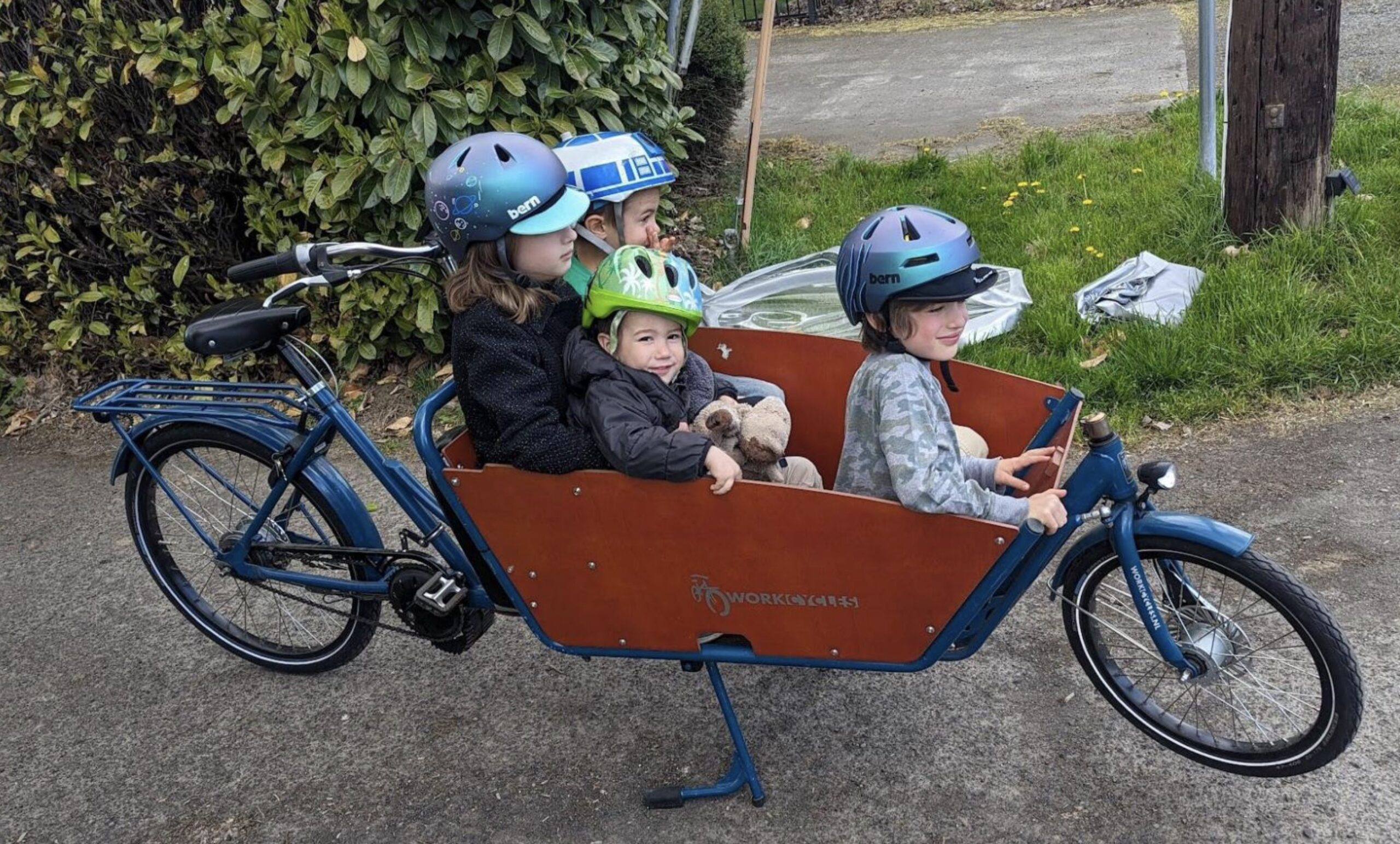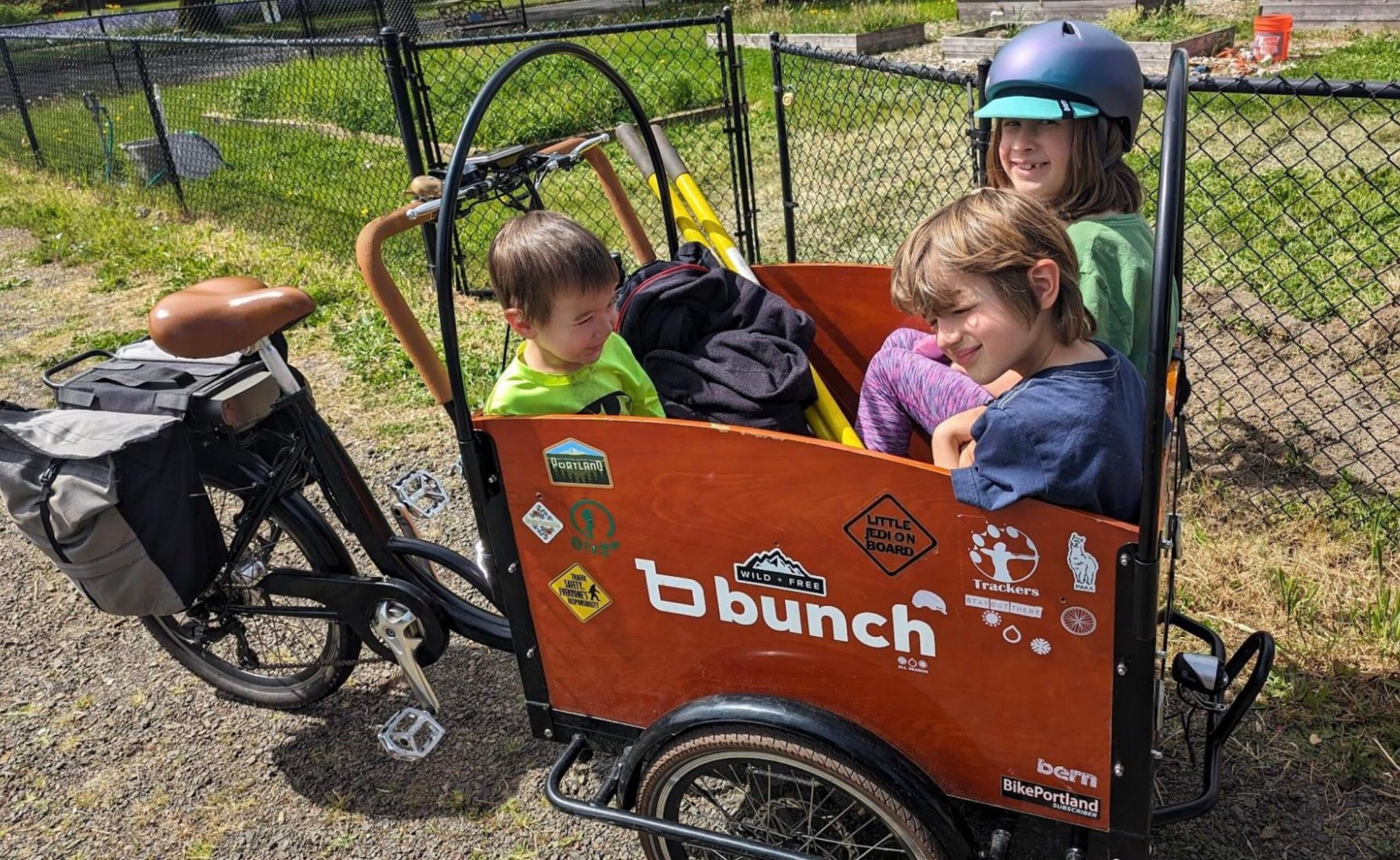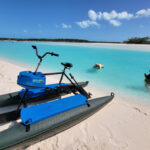Choosing the right bike for your family can feel like navigating a maze. For parents aiming to incorporate more exercise into their daily routines while keeping their children close, the decision becomes even more nuanced. This exploration delves into the journey of one parent seeking the ideal family bike, weighing different models and functionalities to find the best fit for their active family lifestyle. The goal? To transition from a comfortable e-trike to a more workout-oriented, human-powered option, perfectly suited for family adventures with both young and independently riding children.
This quest involves test-riding various Family Bikes, each with its own set of pros and cons. From sturdy steel frames to nimble aluminum designs, and from electric-assist models to purely pedal-powered machines, the options are vast. Let’s dive into a detailed look at four distinct paths in the search for the ultimate family bike.
Option 1: The Steel Steed – A Classic Dutch Family Bike
 Dutch Workcycles Bakfiets family bike in blue, showcasing its classic design and spacious cargo box.
Dutch Workcycles Bakfiets family bike in blue, showcasing its classic design and spacious cargo box.
The allure of a classic Dutch family bike is undeniable, conjuring images of effortless rides and timeless style. The Workcycles Bakfiets, a steel-framed beauty, immediately captured attention. Inspired by stories of mothers effortlessly cycling with numerous children on similar bikes, the idea of a human-powered version was particularly appealing. This test model, however, came with an aftermarket motor, presenting an interesting dilemma: embrace the electric assist or focus on its potential as a purely pedal-powered family bike?
Key Features:
- Model: Workcycles Bakfiets
- Source: Used, local seller
- Price: $3,500 (including rain cover and motor)
- Frame Material: Steel
The Upsides:
- Kid-Approved Comfort: Children adored this bike, emphasizing its smooth and comfortable ride, especially within the spacious cargo box.
- Effortless Electric Assist: The motor provided a significant boost, making starts easy and rides fast, a definite plus for navigating city streets.
- Spacious Cargo Area: The box offered ample room and comfortable bench seating, ideal for younger passengers.
- Aesthetically Pleasing: Its classic design and appealing blue color made it a visually striking choice.
The Downsides:
- Significant Weight: Even without passengers, the bike felt heavy and cumbersome, raising concerns about unassisted pedaling.
- Upright Riding Position: The swept-back handlebars and upright posture were not conducive to a sporty, exercise-focused ride.
- Motor Removal Required: To achieve the goal of a human-powered family bike, motor removal would be necessary, incurring additional cost and effort.
- Braking Concerns: The brakes required considerable force, causing a slight lack of confidence in stopping power, especially with a full load.
- Maneuverability at Low Speeds: Handling felt unstable and heavy when starting, stopping, or moving slowly, increasing the worry of tipping when loaded with children.
- Rain Cover Issues: The rain cover was disliked by the children for being too restrictive and incompatible with helmets.
In Conclusion:
While the Workcycles Bakfiets excelled as a comfortable and stylish e-bike, its heavy frame and cumbersome handling without the motor made it less appealing as a human-powered family bike for exercise-focused family rides. The electric assist was fantastic, but ultimately detracted from the core goal of pedal-powered family fitness.
Option 2: The Jittery Speedster – A Lightweight Aluminum Cargo Bike
Seeking a lighter and faster option, the Yuba Supercargo front cargo bike emerged as a compelling alternative. With its aluminum frame and focus on agility, this family bike promised a different riding experience. Testing the e-version without engaging the assist provided a true feel for its non-electric potential.
Key Features:
- Model: Yuba Supercargo Front Cargo Bike (non-electric)
- Price: $3,734 (including box, rain cover, and seat)
- Frame Material: Aluminum
- Steering: Cable Steering
The Upsides:
- Lightweight and Fast: The aluminum frame and fabric box construction resulted in a noticeably lighter bike that felt quick and easy to pedal.
- Responsive Handling: The cable steering was incredibly responsive, allowing for sharp turns and a nimble feel.
- Powerful Brakes: The brakes were exceptionally effective, providing confident stopping power.
- Step-Through Frame: The step-through design offered ease of mounting and dismounting, a practical feature for everyday use.
- Comfortable Riding Position: The handlebars and seat provided an athletic and comfortable riding posture, well-suited for longer rides.
- Exciting Ride Feel: This bike felt genuinely fun and engaging to ride, even without electric assistance.
The Downsides:
- Overly Responsive Steering: The cable steering, while nimble, proved too sensitive, leading to a wobbly front wheel and instability, particularly at lower speeds and on uneven terrain.
- Bumpy Passenger Ride: The lightweight frame and responsive steering translated to a less smooth and bumpier ride for passengers.
- Children’s Discomfort: Children expressed discomfort and unease due to the wobbly steering and bumpy ride, impacting their overall experience.
In Conclusion:
The Yuba Supercargo offered an exciting and lightweight ride, fulfilling the desire for a faster, human-powered family bike. However, the overly sensitive cable steering and bumpy ride for passengers were significant drawbacks. While the rider enjoyed the speed and agility, the children’s discomfort raised concerns about its suitability for regular family outings.
Option 3: Splendidly Smooth and Steady – The Custom Bullitt Family Bike
For a blend of performance and customization, the Larry vs Harry Bullitt family bike stood out. Known for its high-quality construction and made-to-order options, the Bullitt promised a more refined and tailored family bike experience. This test ride focused on a human-powered model to truly assess its pedal-powered capabilities.
Key Features:
- Model: Larry vs Harry Bullitt (human-powered)
- Price: Approximately $4,000 (customizable)
- Frame Material: Aluminum
- Steering: Solid Arm Steering
- Customization: Wide range of frame lengths and cargo box options
The Upsides:
- Customizable Dream Bike: The ability to customize components and build a bike to personal specifications was a major draw.
- Smooth and Stable Ride: Children immediately approved of the smooth and steady ride, emphasizing its comfort.
- Confident Steering: The solid arm steering provided stable and predictable handling, inspiring confidence.
- Powerful Brakes: The brakes were strong and responsive, ensuring secure stops.
- Kid-Friendly Comfort: Despite a slightly smaller cargo box in the test model, children found the ride comfortable and enjoyable, even on a longer test ride.
- Support for Local Business: With cargo boxes made in Portland and customization through a local shop, it offered a community-focused purchase.
- Aesthetically Appealing Design: The Bullitt is undeniably a beautiful and well-designed bike.
- Perceived Value: The high quality and customization options justified the investment in a potentially long-lasting family bike.
The Downsides:
- Heavier Feel: The test model, possibly due to a wooden cargo box, felt heavier than expected, impacting perceived speed.
- Slower Pace: Compared to the Yuba, the Bullitt felt slower and required more effort to pedal, though this could be influenced by the specific build and test conditions.
- Initial Lack of “Love”: The test model’s handlebars and seat weren’t immediately appealing, highlighting the importance of customization for personal preference.
- No Bench Seats (in test model): The absence of bench seats in the tested cargo box limited passenger space and under-seat storage.
In Conclusion:
The Larry vs Harry Bullitt presented a compelling option as a high-quality, customizable family bike with a smooth and stable ride. While it felt heavier and slower than the Yuba in the test, the customization potential and positive feedback from children made it a strong contender. The Bullitt represents a dream family bike that could be tailored to perfection, albeit with a higher price point.
Option 4: Sticking with the E-Trike – The Comfortable and Convenient Choice
 Electric trike with a large front cargo box, parked on a paved path, representing the option to keep the current family bike.
Electric trike with a large front cargo box, parked on a paved path, representing the option to keep the current family bike.
The final option is a pragmatic one: retain the current electric trike. This choice prioritizes comfort, convenience, and existing familiarity over the pursuit of a human-powered, exercise-focused family bike.
Key Features:
- Model: Current e-trike
- Power: Electric Assist
- Cargo: Large front box with bench seats
The Upsides:
- Maximum Comfort: The e-trike offers a relaxed and comfortable ride for both rider and passengers.
- Spacious Cargo and Storage: The large cargo box and storage capacity are highly practical for family errands and outings.
- Effortless Electric Assist: The motor provides easy starts, hill climbing assistance, and a generally leisurely riding experience.
- Cost Savings: Choosing the existing trike avoids the expense of purchasing a new family bike.
The Downsides:
- Limited Exercise: The electric assist minimizes physical exertion, hindering the goal of increased family fitness.
- Less Agile Handling: Trikes are inherently less maneuverable than bikes, especially in tight spaces.
- Potential for Gym Membership Instead: Sticking with the e-trike might necessitate a separate gym membership to achieve personal fitness goals.
In Conclusion:
Keeping the e-trike is the most convenient and cost-effective option, prioritizing comfort and ease of use. However, it directly contradicts the desire for a human-powered family bike and increased physical activity. This option represents a trade-off between convenience and fitness goals.
Making the Family Bike Choice: Balancing Needs and Preferences
Choosing the right family bike is a deeply personal decision, influenced by individual priorities, family needs, and riding preferences. This exploration highlights the diverse options available, from classic steel family bikes to lightweight aluminum cargo bikes and customizable, high-performance models.
Ultimately, the ideal family bike balances the rider’s desire for exercise with passenger comfort and practical considerations. Factors such as weight, handling, steering responsiveness, and ride smoothness all play crucial roles in the overall family biking experience.
What would you choose? Have you navigated the world of family bikes? Your experiences and insights are invaluable. Share your thoughts and help guide the ongoing quest for the perfect family bike!

